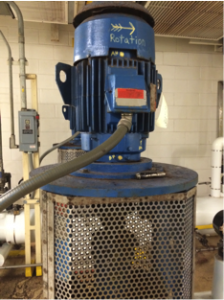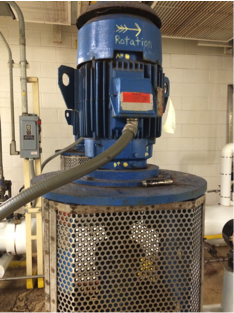Vertical pumps are used in many applications in industry. In many cases, the vertical pumps utilize a C-face flange mounting arrangement. In this arrangement, the shaft  end of the motor mounts onto an adaptor plate. It is held in place by bolts, but is positioned using a grooved joint around the periphery of the motor and plate. This joint typically seats the motor shaft centerline concentrically with the pump shaft, with only a few thousandths of an inch of error possible.
end of the motor mounts onto an adaptor plate. It is held in place by bolts, but is positioned using a grooved joint around the periphery of the motor and plate. This joint typically seats the motor shaft centerline concentrically with the pump shaft, with only a few thousandths of an inch of error possible.
But this does not mean that the alignment quality of such machines should not be checked, especially if vibration is excessive, or if seals and bearings require frequent replacement.
Some of the more common reasons for misalignment of vertical pumps are:
- Dirt, paint, or other contaminants on the mounting surface of the motor or plate.
- Burrs or dents on the mounting surface of the motor or plate.
- On rare occasions, machining errors may be present on the mounting surfaces.
When these motors are removed for maintenance, great care should be taken to not damage the mounting surfaces. The motor should be set on wooden cribbing. And before remounting the motor, the mounting surfaces should be cleaned, stoned, and checked for any other imperfections or damage. The groove on the C-face mounting should also be cleaned, to make sure no dirt or other contaminants are in the groove.
If precision alignment is required, many laser alignment tools offer options for performing vertical alignment.





What is the best way to align a vertical hollow shaft motor?
If you are talking about large hollow shaft motors, like those used in hydro, I would recommend you follow the manufacturer’s recommendations. Many of these large motors are aligned by using a dial indicator to measure a machined surface inside the adaptor. This allows the motor shaft to be placed concentrically within the adaptor.